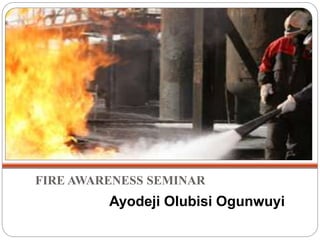FIRE AWARENESS SEMINAR
- 1. FIRE AWARENESS SEMINAR Ayodeji Olubisi Ogunwuyi
- 2. WHAT IS FIRE AWARENESS ALL ABOUT? It is an aspect of HEALTH AND SAFETY(HSE) that deals with; ï Fire Prevention ï Fire hazards ï Fire protection
- 3. FIRE PREVENTION ï This covers precautionary activities aiming at stopping the outbreak of fire, early detection and reducing losses of life and property should a fire occur. ï The activities included are; ïEducation ïInspection ïEnforcement of safety regulations and ïThe reduction of fire hazards wherever possible.
- 4. FIRE HAZARDS (FIRE DANGER) ï The relative likelihood of the start and spread of a fire or an explosion, which might endanger lives or property.
- 5. FIRE PROTECTION ï It implies methods of prevention, early detection and control of any fire incident to mitigate damage or loss. There are two types of fire protection: ïķ Active fire protection which involves installation of sprinklers and automatic detection and extinguishing systems as well as training occupants in fire skills etc ïķ Passive fire protection which refers to structural measures, fire retardant treatment, adequate and
- 6. AIM To provide with an understanding of fire and actions to be carried out in the events of a fire risk.
- 7. OBJECTIVES At the end of this seminar, the participants will be able to; ï Identify fire hazards ï Be aware of the various causes of fire ï Be aware of safety precautions and good housekeeping required to minimize fire ï Understand what fire is and how it spreads ï Identify and select an appropriate fire extinguishers ï Employ the correct techniques for its application.
- 8. WHAT IS FIRE? ï Fire is a rapid combination of two or more substances resulting in the production of heat and light ï It is produced by the process of combustion; a chemical reaction process involving rapid oxidation or burning of a fuel.
- 9. HOW FIRE STARTS It needs three elements to occur: ïķ FUEL - Fuel can be any combustible material â solid (e.g. paper, wood fabrics), liquid (e.g. petrol, diesel, adhesives) or gas (e.g. acetylene, butane, propane). Most solids and liquids become a vapor or gas before they will burn. ïķ OXYGEN - The air we breathe is about 21 percent oxygen. fire only needs an atmosphere with at least 16 percent oxygen. ïķ HEAT - Heat is the energy necessary to increase the temperature of the fuel to a point where sufficient
- 10. CHEMICAL REACTION ï A chain reaction can occur when the three elements of fire are present in the proper conditions and proportions. Fire occurs when this rapid oxidation, or burning takes place. ï Take any one of these factors away, and the fire cannot occur or will be extinguished if it was already burning.
- 11. HOW FIRE SPREADS Fire spreads by four main processes ïķConduction ïķConvection ïķRadiation ïķDirect burning
- 12. CONDUCTION Movement of heat from regions of higher temperature to regions of lower temperature through the molecules of substances in contact with the heat. ï Metals are the best agents of conduction. ï In fire situation, a steal beam passing through a fireproof wall can be the cause of spread from one compartment to another.
- 13. CONVECTION RADIATION ï Heat is transferred from places of higher temperature to places o f lower temperature with visible movement of the medium, usually liquids and gases. ï In fire situations, convectional currents can convey hot gases, smoke and fire brands produced by fire upwards through stair wells, open lift shafts and other opening, thus spreading fire to the upper parts of the building. ï Movement of heat from the source to the other objects without the intervening medium necessary being heated. ï In fire situation, radiant heat may be concentrated by an object such as magnifying glass on combustible materials resulting in further fire spread.
- 14. CLASSIFICATION OF FIRE Fire are classified according to the materials involved: ïķ CLASS A: Involves free combustible materials e.g. wood, paper, textiles etc ï Best extinguishing medium is water. ïķ CLASS B: Involves flammable liquids e.g. petrol, diesel, adhesives etc or liquefiable solids e.g. wax, fats, coal tar etc ï Best extinguishing medium is foam. ïķ CLASS C: Involves gases e.g. methane, propane, butane etc ï The best extinguishing media is vapourising liquids e.g. CO2 ïķ CLASS D: Involves metals e.g. Aluminium, Potassium, Magnesium etc ï The best extinguishing medium is Dry Chemical Powder ïķ CLASS F: Involve cooking fats.
- 15. USES OF FIRE Controlled fire can be used for the following; ïķIndustrial uses ïķDomestic uses- cooking, house heating
- 16. CAUSES OF FIRE Fire accidents occurs when fire is not properly handled or is allowed to get out of control. It could be as a result of; ïķ CARELESSNESS: Most common cause of fire and could manifest as a result of; ï overload electrical sockets ï storing of flammable liquids in homes and offices without adequate protection ï careless handling of cooking gas ï children playing with matches or naked fire ï lighting of candles without adequate protection at the base ï careless smoking habits
- 17. CAUSES OF FIRE contd. ïķWILFUL ACTS: Better known as arson and could manifest as a result of; ïviolent political activities ïattempt to cover crimes of a serious nature ïpublic demonstration/ workmen strike action ïjealousy ïķACCIDENT: An unforeseen circumstances beyond human control resulting in; ïfire outbreak ïearthquake ïthunder storm/lightening ïvolcanic eruption
















